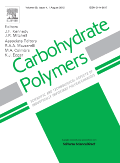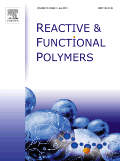
DESIGNED MONOMERS AND POLYMERS
Scope & Guideline
Connecting researchers with the latest in polymer innovations.
Introduction
Aims and Scopes
- Synthesis of Novel Polymers:
Research in this area involves the development of new polymeric materials through various synthetic routes, including but not limited to copolymerization, ring-opening polymerization, and electrospinning techniques. - Characterization Techniques:
A significant focus is placed on the characterization of these synthesized polymers using advanced analytical methods such as NMR, FTIR, DSC, and rheological studies to understand their thermal, mechanical, and chemical properties. - Applications in Biomedical Engineering:
The journal frequently publishes studies exploring the application of polymers in biomedical fields, including drug delivery systems, tissue engineering, and antimicrobial materials. - Environmental and Sustainable Materials:
There is a growing emphasis on developing bio-based and environmentally friendly polymers, focusing on sustainability and the reduction of environmental impact. - Nanocomposite Development:
The exploration of polymer nanocomposites, particularly those incorporating nanoparticles for enhanced properties, is a core area of research, highlighting the intersection of polymer science with nanotechnology.
Trending and Emerging
- Thermoresponsive and Smart Polymers:
There is an increasing number of studies focusing on thermoresponsive polymers and smart materials that can respond to environmental stimuli, which have significant potential in drug delivery and adaptive materials. - Biopolymer and Green Chemistry Innovations:
Research on biopolymers and the application of green chemistry principles in polymer synthesis are trending, as sustainability becomes a key focus in materials science. - Advanced Drug Delivery Systems:
The development of advanced, targeted drug delivery systems utilizing polymeric nanocarriers is a rapidly growing area, especially in the context of cancer therapy and regenerative medicine. - Nanotechnology in Polymers:
The integration of nanotechnology into polymer science is increasingly prominent, with studies exploring the incorporation of nanoparticles for enhanced mechanical, thermal, and optical properties. - Functionalized Polymers for Specific Applications:
There is a noticeable trend towards the synthesis of highly functionalized polymers tailored for specific applications, such as antimicrobial, antifouling, or responsive materials.
Declining or Waning
- Traditional Polymerization Methods:
There seems to be a waning focus on conventional polymerization techniques, such as bulk or solution polymerization, as researchers increasingly explore more innovative and efficient methods. - Non-Biodegradable Polymers:
The trend towards sustainability has led to a reduced emphasis on non-biodegradable polymers, with researchers favoring biodegradable alternatives and environmentally friendly materials. - Generalized Polymer Coatings:
The publication of studies on generic polymer coatings has decreased, possibly due to the saturation of knowledge in this area and the shift towards more specialized coatings with specific functional properties.
Similar Journals

JOURNAL OF POLYMER RESEARCH
Fostering Knowledge in Materials and Organic ChemistryJOURNAL OF POLYMER RESEARCH is a leading peer-reviewed journal published by SPRINGER, specializing in the dynamic fields of polymer science, materials chemistry, and organic chemistry. Operating since 1994, this esteemed journal has consistently delivered high-quality research articles that illuminate the latest advancements and innovations in polymer technology. With an increasing impact factor and placed in the Q2 category for both Materials Chemistry and Polymers and Plastics, it stands as a valuable resource for researchers, professionals, and students seeking cutting-edge knowledge in these areas. The journal is indexed in Scopus, highlighting its significance in the academic community, with notable rankings in Materials Science and Organic Chemistry. While it does not currently offer open access options, the meticulous selection of research and thorough peer-review process ensures each article's contribution to the field is both robust and impactful. Researchers aiming to expand their understanding and engage with pioneering studies will find JOURNAL OF POLYMER RESEARCH an indispensable platform.

Carbohydrate Polymers
Unveiling the potential of carbohydrate polymers.Carbohydrate Polymers is a prestigious academic journal, published by ELSEVIER SCI LTD, that plays a vital role in the field of materials chemistry, organic chemistry, and polymer science. With its Q1 category rankings in these domains, this journal serves as a critical platform for disseminating high-quality research, innovative methodologies, and significant advancements in carbohydrate-based polymers. Since its inception in 1981 and continuing until 2025, it has fostered critical discussions and collaborations among researchers, professionals, and students worldwide. Although it does not offer open access, its rigorous peer-review process ensures that only the most impactful studies are published. By highlighting new developments in the synthesis, characterization, and application of carbohydrate polymers, Carbohydrate Polymers consistently contributes to the enhancement of knowledge and technology within its field, making it an essential resource for anyone working at the intersection of chemistry and materials science.

BULLETIN OF MATERIALS SCIENCE
Charting New Territories in Materials InnovationBulletin of Materials Science, published by the Indian Academy of Sciences, is a distinguished journal that has been contributing to the field of materials science since its inception in 1979. With an ISSN of 0250-4707 and E-ISSN 0973-7669, it provides a platform for researchers to share groundbreaking studies and advancements in the mechanics of materials and general materials science. As of 2023, the journal holds a respectable Q3 ranking in both the Materials Science (miscellaneous) and Mechanics of Materials categories, highlighting its competitive position in the academic landscape. Although the journal currently does not operate under an open access model, it remains a vital resource for professionals and students keen on exploring innovative material developments and methodologies. With a commitment to promoting high-quality research, the Bulletin of Materials Science features rigorous peer-review processes, making it an essential reference for anyone engaged in the materials science domain.

Journal of Macromolecular Science Part A-Pure and Applied Chemistry
Bridging Theory and Application in Macromolecular ScienceWelcome to the Journal of Macromolecular Science Part A - Pure and Applied Chemistry, a distinguished publication dedicated to advancing the understanding of macromolecular science, encompassing critical areas such as polymers, materials chemistry, and composites. Published by Taylor & Francis Inc, this journal has firmly established its place within the scientific community, evident from its ranking in the Q2 and Q3 quartiles across various categories in the latest assessments, including Polymers and Plastics as well as Ceramics and Composites. With a commitment to providing high-quality peer-reviewed content, the journal aims to facilitate knowledge exchange and innovation among researchers and practitioners from around the globe. The absence of open access underscores the journal's commitment to maintaining rigorous editorial standards while remaining accessible to its readership. As the journal converges through valuable research contributions from 1992 to 2024, it continues to be a pivotal resource for professionals and students seeking to explore the latest advancements and applications in the field of macromolecular science.

REACTIVE & FUNCTIONAL POLYMERS
Unveiling Breakthroughs in Reactive and Functional Polymer ResearchREACTIVE & FUNCTIONAL POLYMERS, published by Elsevier, is a leading journal in the field of polymer science, focusing on the innovative development and application of reactive and functional polymers. With an impressive impact demonstrated through its classification in various prestigious categories, including Q1 rankings in Chemical Engineering, Chemistry, and Materials Chemistry, this journal serves as an essential resource for researchers and professionals seeking to explore the latest advances in polymer research. With a broad scope that encompasses topics from biochemistry to environmental chemistry, and a convergence of significant findings from 1995 to 2024, REACTIVE & FUNCTIONAL POLYMERS fosters academic dialogue and collaboration among scientists. The journal also features Open Access options, ensuring that groundbreaking research is readily available to a global audience. By consistently publishing high-quality articles, it not only enriches the scientific community but also drives innovation across various industries reliant on polymer technologies.

Applied Materials Today
Transforming Research into Real-World Solutions.Applied Materials Today is a leading peer-reviewed journal published by ELSEVIER, dedicated to the field of materials science. With an impressive impact factor and ranked in the Q1 category for materials science (miscellaneous) in 2023, this journal stands out as a crucial platform for sharing groundbreaking research and innovative applications of materials. Based in the Netherlands, the journal has rapidly gained recognition, achieving a remarkable Scopus ranking of 41 out of 463, placing it in the 91st percentile among general materials science publications. Covering a broad range of topics, from the synthesis and characterization of materials to their practical applications, Applied Materials Today seeks to inspire and inform researchers, professionals, and students alike. Its commitment to disseminating high-quality, open-access content ensures that cutting-edge discoveries in materials science can be shared with a global audience, fostering collaboration and advancements in the field.

Polymers
Unveiling the potential of polymers for industrial progress.Polymers is a premier journal published by MDPI, dedicated to advancing the field of polymer science and technology. This open-access journal, established in 2009, has quickly gained prominence in the academic community, serving as a vital platform for disseminating high-quality research articles, reviews, and communications in the realms of chemistry, polymers, and plastics. Based in Switzerland, with an impressive ranking in the Q1 quartile for both Chemistry and Polymer studies, Polymers boasts a significant impact factor, reflecting its rigorous peer-review process and esteemed editorial board. Researchers, professionals, and students alike benefit from the broad accessibility of content, allowing for a more extensive reach and engagement within the scientific community. As a key resource for the latest advancements and innovations in polymer research, Polymers continues to lead discussions, inspire collaborations, and foster the development of novel materials that shape various industrial applications.

POLYMER JOURNAL
Exploring the Dynamics of Polymers and PlasticsPOLYMER JOURNAL, published by SpringerNature in the United Kingdom, is a premier academic platform dedicated to the field of polymer science. Since its inception in 1971, this journal has become an essential resource for researchers and professionals interested in the latest advancements in materials chemistry, polymers, and plastics. With its robust H-index and a consistent ranking in the top quartiles of its categories—Q2 in both Materials Chemistry and Polymers and Plastics—POLYMER JOURNAL demonstrates a strong impact in the scientific community. It holds significant recognition in Scopus rankings, occupying the 68th percentile in Materials Chemistry and the 67th percentile in Polymers and Plastics. The journal's commitment to publishing high-quality research articles enables it to serve as a key reference point for innovative studies, theoretical developments, and practical applications in polymer science. Although it is not an open-access journal, researchers and students gain valuable insights through its extensive archives and rigorous peer-reviewed content, making POLYMER JOURNAL a vital source of knowledge for anyone engaged in this dynamic field.

IRANIAN POLYMER JOURNAL
Exploring New Dimensions in Materials ChemistryWelcome to the Iranian Polymer Journal, an esteemed publication encompassing a rich history since its inception in 1996 and extending its scholarly reach up to 2024. Published by Springer from Switzerland, this journal stands out in the fields of Chemical Engineering, Materials Chemistry, and Polymers and Plastics, proudly holding a Q2 category ranking in each of these disciplines for 2023. With an ISSN of 1026-1265 and an E-ISSN of 1735-5265, the journal serves as a vital resource for researchers, professionals, and students, offering insights into polymer science and interdisciplinary applications. Although not an open-access journal, it presents an invaluable platform for high-quality research dissemination and robust peer-reviewed articles. With Scopus rankings indicating its respected position within the academic community, the Iranian Polymer Journal is committed to advancing knowledge and fostering innovation in polymer-related studies, making it an essential addition to your research library.

Materials Today
Transforming Ideas into Material BreakthroughsMaterials Today is a premier academic journal published by Elsevier Science Ltd, specializing in the dynamic fields of materials science, mechanical engineering, and condensed matter physics. Established in 1999, the journal has garnered an enviable reputation, consistently ranking in the Q1 category across multiple disciplines including mechanics of materials and general materials science, reflecting its influence and high-quality research output. With an impressive Scopus ranking—4th in both mechanical engineering and mechanics of materials, and 6th in condensed matter physics—Materials Today serves as an essential resource for researchers, professionals, and students seeking to stay at the forefront of developments in material innovations and applications. The journal is known for its commitment to publishing significant research findings and reviews, making it a vital platform for disseminating knowledge and fostering collaboration in the rapidly evolving materials field. Although it does not offer open access, its robust impact factor underscores the importance of the content published, ensuring wide visibility and citation among the academic community. Explore the rich tapestry of materials research with Materials Today, where groundbreaking insights pave the way for future technological advancements.